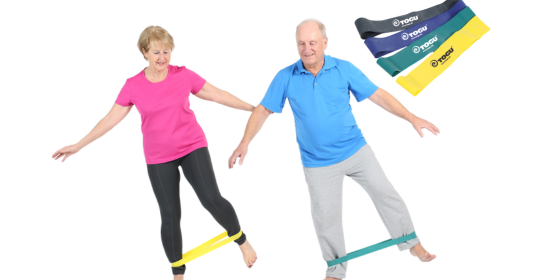Fitness bands, also known as exercise bands, resistance bands or resistance bands, are a popular exercise tool for fitness enthusiasts.
But what exactly are exercise bands and how are they used? In this article we will explain everything you need to know.
What are exercise bands?
Exercise bands are elastic bands made of rubber, latex or fabric and are available in different lengths and thicknesses. They are an effective tool for training strength, endurance, agility and flexibility. The exercise bands provide continuous resistance and can be used for a variety of exercises, from isolated resistance exercises to full-body workouts. As part of a workout, they can also be used for a warm-up and stretching to improve flexibility and range of motion.
They are lightweight, easy to transport and a cost-effective alternative to other exercise equipment such as dumbbells or machines. Fitness bands have thus become a popular piece of fitness equipment for use at home or in the gym.
What can exercise bands be used for?
Fitness bands are extremely versatile exercise equipment that can be used for various workout purposes. As part of a workout, they can be used for warm-ups and stretching to improve flexibility and range of motion. Resistance exercises such as biceps curls, shoulder presses and squats can be intensified with exercise bands, allowing for effective strength training. Exercise bands can also be used to isolate and strengthen muscles, and for dynamic exercises such as rotations or side-to-side movements to improve balance and coordination.
Another advantage of fitness bands is that they allow for a full-body workout, covering all major muscle groups. Whether in the gym or at home, fitness bands are a great option to diversify your workout and challenge yourself.
How do you choose the right elastic band for sports?
When buying fitness bands, there are some important factors to consider to make sure you choose the right fitness band for your fitness level and workout goals. Here are some tips you should consider:
- Resistance Level: Choose the right resistance level according to your fitness level and training goals. Too low resistance will not make your workout intense enough, while too high resistance can overwhelm you.
- Material and Durability: Pay attention to the material and durability of the fitness band to ensure a long life and a safe workout. Rubber and latex bands are the most durable, while fabric bands may have less durability.
- Length and width: Choose a fitness band with the right length and width for maximum results and versatility. A fitness band that is too short can limit your mobility, while a fitness band that is too wide can be impractical for some exercises.
- Advice from an expert: If you’re unsure which fitness bands are best for you, you should consult a fitness expert who can help you choose the right fitness band.
By considering these factors, you can choose the right fitness band and ensure that your workout is effective and safe.
For which exercises are exercise bands suitable?
This type of exercise with resistance bands can be an excellent addition to strength training and increase muscle strength and size. In addition, elastic bands in sports are great for stretching exercises and improving flexibility. If you choose an appropriate resistance level of fitness band that matches your fitness level and training goals, you can ensure an effective and safe workout.
Here are some examples of exercises using exercise bands or resistance bands that can promote strength training and muscle building:
- Resistance exercises: Biceps curls, shoulder presses, squats, triceps presses, leg presses and pull-ups.
- Full body workout: plank with side leg raises, lunges with arm rows, push-ups with fitness bands and knee raises.
- Rehabilitation: physiotherapy exercises to strengthen joints and muscles.
- HIIT training: interval training with fitness bands to increase cardiovascular fitness.
Why is training with fitness bands so effective?
Training with fitness bands is an extremely effective way to improve strength, endurance, agility and flexibility to achieve your training goals.
One of the reasons why training with fitness bands is so effective is the constant resistance they provide. Unlike free weights such as dumbbells, where the resistance can vary during the movement, the resistance remains constant throughout the movement. This allows for a more targeted workout of the muscles and better control during exercise performance.
The versatility of fitness bands in different strengths is another advantage if you want to increase your workout over time. They can be used for a variety of exercises, from resistance exercises to full body workouts and stretching exercises.
Another benefit of fitness bands is their promotion of flexibility and range of motion by being used for stretching exercises. Regular workouts with fitness bands can improve flexibility and prevent injuries. This is especially important for people who have a sedentary lifestyle or are undergoing rehabilitation.
In addition, fitness bands are also less expensive compared to other exercise equipment such as dumbbells and machines. This makes them an affordable option for those who want to do home workouts. Moreover, they are easy to handle and transport. They can be easily stored in a gym bag or backpack, making them an ideal companion when traveling.
Unsere TOGU Experten raten
Ein einfacher Tipp, um das Maximum aus deinem Training mit Fitnessbändern herauszuholen: Achte auf die richtige Technik und Form. Es ist wichtig, langsam und kontrolliert zu arbeiten und sicherzustellen, dass das Fitnessband sicher befestigt ist, um Verletzungen zu vermeiden und die besten Ergebnisse zu erzielen.
Außerdem solltest du darauf achten, das richtige Widerstandsniveau zu wählen, um eine Überanstrengung der Muskeln zu vermeiden und ein effektives Training zu ermöglichen. Indem du diese einfachen Tipps befolgst, kannst du das Beste aus deinem Training mit Fitnessbändern herausholen und deine Fitnessziele schneller erreichen.
Diese Produkte von TOGU könnten Sie interessieren:

